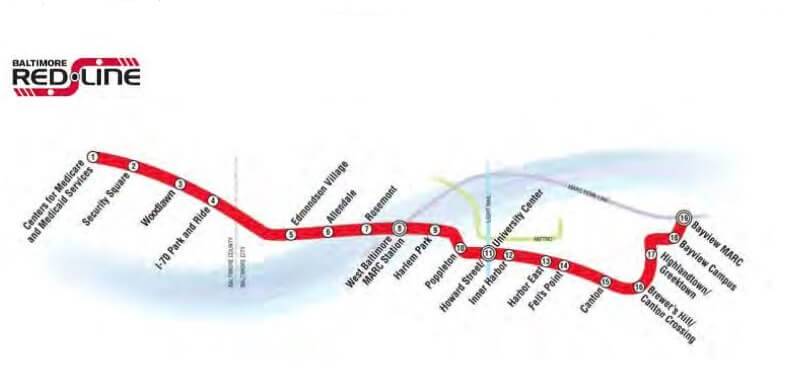
Transportation issues are rarely about getting from here to there. Usually the debate swirls around such tangent matters as money, race, uprooting neighborhoods, jobs and contract awards – almost anything but moving people from one point to another. Now add to the deflection private partners.
Revival of the junked Red Line across Baltimore’s mid-section has snuggled up to education as among the Democrats’ most talked about issues of the campaign for governor. Recall that Gov. Larry Hogan (R) deep-sixed the project as a waste of money and spread the dollars among the outlying counties to build roads. Hogan prefers moving cars than people, asphalt over rail. Or put another way, Hogan put the money where his votes are because he couldn’t carry the city with the help of a handcart.

Frank A. DeFilippo
Transportation in Maryland is verily an urban, suburban, rural competition on how to divvy up dollars. It has always come down to this formulation: Why should drivers in suburban and rural counties pay most of the gas taxes that would be used to build transit systems for urbanites who pay far less taxes?
On the drafting boards are also express toll lanes along the Capital Beltway and I-270 as well as resuscitating plans for a rapid bus system on the I-270 corridor. Lump those in with Hogan’s idea to add four lanes to the Baltimore-Washington Parkway if the federal government will deed the heavily traveled autobahn to Maryland, and the Greater Washington Partnership’s pipedream of a network of toll roads stretching from Baltimore to Richmond, Va.
And for those who prefer rail to rubber, the first shovel of dirt has been turned for the Purple Line linking Montgomery and Prince George’s Counties, and Hogan has committed $165 million a year, along with similar pledges from Virginia and the District, to help underwrite the Washington Metro’s first dedicated source of funding.
We are, citizens, plop in the middle of the worst traffic congestion in America. And it can only get worse, not better. In addition to the 2.6 million vehicles registered in Maryland, the state has the geographic distinction of being a pass-through state. That is, anything on wheels heading north or south passes through Maryland to get where it’s heading. And they leave behind only fumes, potholes, debris and a few bucks in gas taxes when they stop for a fill-up.
Maryland’s unique unified transportation fund has been under severe strain despite fine-tuning the gas tax several legislative sessions ago. The Intercounty Connector linking Montgomery and Prince George’s counties is a financial bust because tolls have fallen way short of projections. And former Gov. Robert L. Ehrlich Jr. (R) hocked the fund’s future by issuing so-called GARVEE bonds against anticipated transportation revenues.
And consider this: Hogan has made a big deal of eliminating the cost of transponders for Marylanders in the EZpass program and further reducing tolls on the Chesapeake Bay Bridge and other crossings. It should be noted to fans of free transponders that each reduction in tolls and fees translates to a reduction in the funding available for the tollways and bridges operated by the Maryland Transportation Authority.
Hogan is giving away 400,000 transponders, @$7.50. You do the math. So the more Hogan compromises that funding with vote-grabbing give-aways, the fewer dollars there are to pay for maintenance and improvements (or another Chesapeake Bay Bridge that’s on his Ambien list).
Hogan, stirring up the juices of motorists in the car-strangled state, has hitched Maryland’s transportation future to public private partnerships. One such arrangement, a fast-tracked $68.5 million management contract, was recently recalled for reworking when it was revealed that – ooops! – the transportation secretary, Pete K. Rahn, forgot to mention that he had been an employee of one of the firms he recommended.
The problem with PPPs is that the private partners in the deal can’t be voted out of office if they mess up. What’s more, PPPs are profit centers not public servants. For example, when the state of Indiana sold its turnpike to a private firm, the company later filed for bankruptcy and stiffed the public with the debt and the bill for neglected repairs.
Privatized prisons, similar but not identical to PPPs, make money by locking people up. They are notorious for scrimping on food, safety and rehabilitation programs to boost profits and in many instances are less effective than government-run prisons. So inefficient were they deemed that the Obama Justice Department began to phase them out.
PPPs and private ownership of government services are part of the cherished Republican dream of turning most functions of government over to the private sector except the defense of the nation and the power to tax. The Post Office is a good example. Free-market Republicans are squeezing the Post Office with pension and other requirements, hoping to shut it down and shuffle the work to outfits such as UPS and FedEx. A state as wealthy as Maryland should be wary of using resources intended for its people to enrich private profit centers. (n.b., The Port of Baltimore is now a public-private partnership.)
Hogan inherited the proposed Red Line from his predecessor, former Gov. Martin O’Malley (D). Hogan dumped the project because, he argued, it was too costly at $2.9 billion. In doing so, he gave up $900 million in federal funding and distributed the state’s share of the intended funding to the rural counties where roads rule.
The problem with the Red Line was not so much its cost but its design. It proposed building a tunnel next to a tunnel and created a neighborhood fuss by uprooting Canton by thundering under Boston Street. The good burghers in Canton are also especially sensitive about what kind of folks come to their gentrified neighborhood, as was among the reasons for so many delays on the Purple Line.
The Red Line was designed by O’Malley’s engineers to assuage organized labor, notably the building trades. Labor is not so much interested in locomotion as it is in how many man-hours of work a project creates. (When the first leg of the Baltimore subway was approved, unions estimated that the project would create 2 million man-hours of work.)
And in the Red Line, the man-hours were in tunneling under Boston Street on the east side of town, where it would approach its terminus after originating at Security Boulevard to the west. (To underline the original point, the 1971 proposal to build the Baltimore subway was a payback to the Baltimore Building Trades Unions for its financial and voting support of Gov. Marvin Mandel (D). The building trades had purchased $250,000 worth of tickets to a fundraiser for Mandel and his running-mates, a musical gala featuring the Golddiggers, Lou Rawls and Skitch Henderson, popular entertainers of the 1970s era.) Democracy in action doesn’t come cheap.
A simpler design would have resolved the Red Line’s cost problem: Build a line from Security Boulevard to a connecting point in the existing subway system, say Rogers Avenue, transfer and be on your way.
The original Baltimore subway system was designed to be a continuing “U”, running from Owings Mills though downtown, across to the Johns Hopkins Hospital campus, and out to White Marsh, with spur lines into Anne Arundel and Baltimore counties, and a line traveling under Charles Street from downtown Baltimore to Towson. The lines into Anne Arundel and Baltimore counties were rejected by their executives at the time, specifically in Anne Arundel for racial reasons.
It’s an iron law of development: When government installs the infrastructure, the malls, condos and jobs will follow. There are those who argue that the Red Line is unnecessary, if not redundant. But it’s an accommodation that would transport people to decent paying jobs and onto the tax rolls and into stores and restaurants. And yes, for a change it would be about getting people from here to there without the usual diversionary flack and political fuss.




 Creative Commons Attribution
Creative Commons Attribution